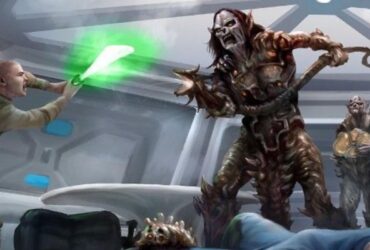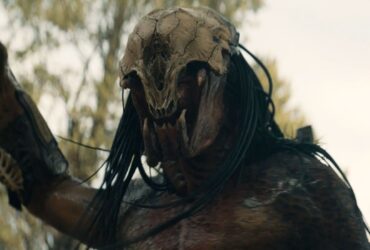Star Trek has a long and well-regarded tradition of using science fiction environments to critique and comment on elements of real-world history. Starfleet employees frequently step into futuristic versions of Ancient Rome, the Wild West, or even 1920s Chicago through one narrative convention or another. Most examples barely stand out. It’s fun to put the sci-fi lens on alternative history or imagine how things might change given the presence of hindsight. Unfortunately, some images from the past carry more weight than others. Star Trek ran afoul of that reality in “Patterns of Force,” an episode largely about the Nazis.
One of the funniest aspects of the internet is its ability to repurpose visual art. A single frame from a movie or TV show can completely encapsulate the meaning behind the original work, sometimes more elegantly than its source. Conversely, it can also become a work of shared expression far beyond the bounds of the source material, unrelated to or in contrast to every other image in the work. Sometimes an episode of TV or a movie can get boiled down to a single shot for the noble art of internet jokes. Modern Star Trek showrunners would probably think twice about giving the fanbase several images of their main cast in Nazi getups.
What happens in “Patterns of Force”?
|
Series |
The Original Series |
|---|---|
|
Episode |
Season 2, Episode 21 |
|
Director |
Vincent McEveety |
|
Written By |
John Meredith Lucas |
|
Release Date |
February 16, 1968 |
“Patterns of Force” begins with the crew of the USS Enterprise reaching a planet called Ekos in search of a missing history professor named John Gill. Upon reaching the area, they discover that the planet is armed with technology far beyond their usual standard, prompting concerns that Gill may have violated the prime directive. Kirk and Spock quickly prove their fears accurate when they land on Ekos to discover Ekosian society acting out a flawless planet-wide recreation of Nazi Germany. Thinking quickly, the heroes don Nazi uniforms to blend into their hostile environment. Kirk and Spock discover that the people of Ekos are ramping up for a genocidal invasion of a peaceful neighboring planet, placing a tight timer on their intervention. Perhaps even more troubling, they also find that the would-be Führer in charge appears to be Professor Gill. Spock’s distinctive ears blow his cover, leading the Nazis to drag both the Vulcan and his captain off to prison to be tortured. Luckily, this grants them an opportunity to meet with the local antifascist movement and gain some valuable information.
An embedded resistance spy informs Kirk that Gill is only a figurehead, and the real leader is his alleged second-in-command, Melakon. Kirk and Spock escape incarceration and seek out Gill, finding him under the effects of heavy sedatives. After McCoy wakes Gill, the historian explains that he found Ekos in a state of unproductive anarchy. Apparently convinced that fascism was Earth’s most “efficient” form of governance, Gill introduced the system to Ekos. Everything apparently went fine until Melakon took over and pushed the whole Nazi thing too far. Without the effects of the drugs, Gill speaks out against the worst excesses of the system he introduced, prompting Melakon to shoot him. In return, an antifascist shoots and kills Melakon. With both leaders dead, the resistance becomes the government and sets to work dismantling the Reich system. Kirk and Spock leave with their heads held high, convinced that the locals can work this out for themselves.
How was “Patterns of Force” received?
Many episodes of Star Trek were banned in one country or another. “Patterns of Force” caught a fairly immediate ban in Germany, where Nazi symbols are banned outside of museums and educational materials. They might have gotten away with the ill-considered costumes, but Gill’s mad assertion that fascism was a notably efficient governmental system was enough to earn the German authorities’ ire. It became the only episode that didn’t make it to Germany during the show’s original run. It only got a German dub 27 years later in 1995. Its first public broadcast in Germany didn’t come until 2011. The BBC also cut it down slightly due to its use of torture. Beyond the controversy, “Patterns of Force” is a compelling episode of TV with a few questionable production decisions.
“Patterns of Force” is certainly not condoning fascism or any Nazi-esque ideology. Aside from the absurd suggestion that fascism is in any way efficient, it would be clear to any viewer that the society depicted is unacceptable. The solution would have been fairly obvious. They could have told the same story with slightly different outfits, reasoning that a society based on Nazi Germany wouldn’t need to look exactly like Nazi Germany, but that’s not what Star Trek did. Instead, fans got to see their favorite captain and first officer wearing swastikas while a bizarre, ill-informed, pseudo-intellectual Nazi whines about efficiency.













Leave a Reply